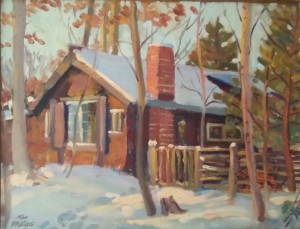One spring afternoon, my mother was driving along a dirt road north of the Credit River, brooding over their need for a better place to live and her love of country scenery. She stopped to sketch two big, leaning poplars, and looked into a lovely, woodsy glen. It was such a beautiful wild place, she remembered later, with immense trees and many wild flowers. On that day the woods were dappled with white trilliums, and the swamp in back of the woods was a vast spread of yellow marsh marigolds. By good fortune, just down the road from the poplars, she discovered a two-and-a-half acre property they could afford by using five hundred dollars they had saved from my father’s overtime work.
Often, later, as her isolation pressed in on her, my mother was to wonder whether the two artists should have stayed in Toronto. But really, she knew they had no choice. She had always loved the country, so for her the decision was easy, but my father, who had
never lived there, and who so loved his city, was doubtful at first. As it turned out though, the Harborn Road [later changed to Harborn Trail] home would become one of the joys of his life.
They started to build a summer cabin the next spring, in 1937 on Coronation Day, as my mother’s journal of the time notes. Because the cabin was destined to become a garage for a future house, my father insisted on a cement floor and garage doors, and actually drove their car in with them. With a bedroom scarcely bigger than a closet, they could scarcely squeeze in bunk beds. It was a particularly damp summer and my mother recalled that, in the closeness under the surrounding trees the mosquitoes were savage.
Both my parents thought they would be relieved in the autumn when cold weather forced them to return to Charles Street. But, once they were back in the city my mother missed her woods profoundly. As a result, they secured a mortgage from Ken’s carpenter father and hired him and my Uncle Joe to work making the cabin into a home over the winter. A basement was dug out with the help of work horses. It turned out to be a very snowy winter but the house grew under a spirit of good cheer, with much help from family. On weekends, both grandfathers, and any other available family members threw themselves into the
building.
The home was to be a simple house in the heart of the woods, clothed in brown-stained shingles, so that it would blend into the forest background. Initially it consisted of a kitchen where the summer cabin had been, a bathroom and a living-room cum studio. It would have large windows (which my parents later discovered let out the heat in winter and left them with nowhere to hang pictures) but then, my parents always considered windows to be the most essential feature of a house.
On Sunday, January 30, 1938, my excited mother wrote in her journal: We went out to see our house. It is so thrilling! It is hard to believe in its reality. To see our plans and little model grow up in a couple of weeks. The windows are placed in the new part and it was such fun seeing the different views from them. It is just four weeks since they started to get the foundation dug. They now have the walls boarded in and nearly half the roof shingled.
By March 9, she blurted “…too busy to write, moving Sat..” However it was not long before the poor planning and lack of money caught up with them. They discovered that, between art
paraphernalia, costumes, props and books, they had accumulated so much that the new house turned out to be more cramped for storage space than their Charles Street apartment. Worst of all, there was no room to set up easels and paint.
How they managed, and even prospered, in spite of the upcoming war, poverty, and a difficult house is a compelling story.

